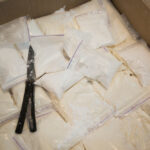The Offence of Possessing a Commercial Quantity of Unlawfully Imported Border Controlled Drug

Police arrested a 29-year old man on Thursday, 2 September 2021 at his home in Mt Colah in Sydney’s north, after raiding several properties including a storage facility in Hornsby.
It has been alleged that the raids led to the seizure of 350 kilograms of heroin, with an estimated street value of $156 million.
Imported in machinery
According to authorities, arrangements for the importation of the drugs from Malaysia in December 2020 were detected during a joint operation between Australian Border Force (ABF), Australian Federal Police (AFP) and the New South Wales Police Force.
In a statement to the media, the AFP says the operation included the tracking and monitoring of air cargo containing two vertical industrial mixers.
The ABF X-rayed the machinery on arrival and allegedly located two metal cases containing heroin, which were later seized by the AFP.
The packages were removed from the machinery, refilled with an innocuous substance, resealed and delivered to the intended address – a storage facility in Hornsby.
Police allege the arrested 29-year old collected the consignment and attempted to access the contents.
A criminal investigation into the crime syndicate said to be responsible for the importation is ongoing.
The arrested man was refused police bail and will face Parramatta Weekend Bail Court today, charged with attempting to possess a commercial quantity of unlawfully imported border-controlled drugs.
The alleged offence
Possessing a commercial quantity of unlawfully imported border controlled drug or plant is an offence under section 307.5 of the Criminal Code Act 1995 which carries a maximum penalty of life in prison.
To establish the offence, the prosecution must prove beyond reasonable doubt that:
- A person possessed or attempted to possess a substance,
- The substance was unlawfully imported,
- The substance was a border controlled drug or plant,
- The person knew, or was reckless as to whether, the substance was a border controlled drug or plant, and
- The amount possessed or attempted to be possessed was the commercial quantity.
A person was ‘reckless’ if he or she was aware it was likely the substance was a border controlled drug or plant, but went ahead with the actions regardless.
What is a commercial quantity?
Examples of a ‘commercial quantity’ of border controlled drug or plant include:
- At least 500 grams of MDMA (or ‘ecstasy’),
- At least 750 grams of amphetamines,
- At least 1.5 kgs of heroin,
- At least 2 kgs of cocaine, or
- At least 100 kgs of cannabis leaf.
A defence to the charge is duress, which is where:
- The conduct was due to a threat of death or serious injury to a person, or someone close to the perso such as a family member,
- There was no reasonable way to render the threat ineffective, and
- The conduct was a reasonable response to the threat.
The illegal use of drugs in Australia
According to most recent National Drug Strategy Household Survey, which was published in 2019, an estimated 9.0 million (43%) people aged 14 and over in Australia had illegally used a drug at some point in their lifetimes.
This figure includes both illegal drugs and the non-medical use of pharmaceuticals.
The data also suggested that an estimated 3.4 million (16.4%) had used an illicit drug in the previous 12 months.
The most common illicit drugs used are cannabis, followed by cocaine and ecstasy.
The survey suggested the use of heroin is uncommon in Australia. The drug is considered to be a highly addictive opioid, and according to survey, opioid use was identified in 61% of drug-induced deaths across the nation.








